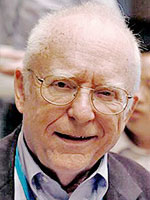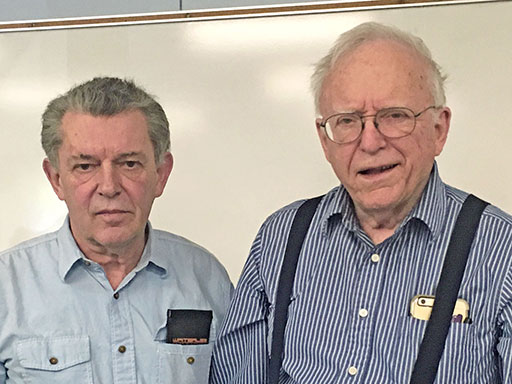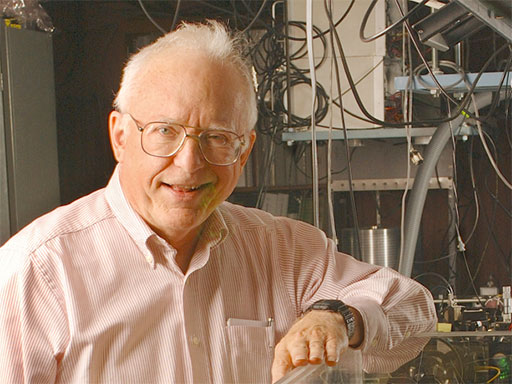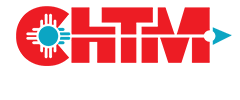Recent News
CHTM Joins NSF's NQVL Pilot Projects
August 9, 2024
OSE PHD, Dr. Xuefeng Li - Wins The Outstanding Interdisciplinary Graduate Programs Award
May 10, 2024
Dr. Ali Rastegari - 2024 OSE Best Dissertation Award Winner
May 10, 2024
2024 OSE Spring and Summer Graduates
May 10, 2024
News Archives
Professor John L. Hall, Nobel Laureate, presents CHTM Distinguished Lecture
May 3, 2016 - CHTM

Physicist John L. Hall
at the 2012 Lindau
Nobel Laureate Meeting
John L. Hall, Nobel Laureate in Physics; Fellow Adjoint, JILA; Senior Fellow Emeritus NIST; Lecturer, University of Colorado-Boulder, Physics Department; presented a CHTM Distinguished Lecture on May 6, 2016: "Intracavity Nonlinear Spectroscopy, technical issues, and scientific opportunities."
The audience in CHTM 103 expressed rapt interest in Dr. Hall's presentation, which was followed by a Q&A session. His schedule during his visit included time for one-on-one appointments with interested students and faculty. Dr. Hall was invited to speak at CHTM by his good friend, Jean-Claude Diels, Professor, Physics & Astronomy Department and faculty member at CHTM.
Dr. Hall shared a few websites with his audience, including the video of his presentation to the Nobel Institute:
- http://jila.colorado.edu/hall/
- http://HallStableLasers.com
- http://nobelprize.org/nobel_prizes/physics/laureates/2005/hall-lecture.html (link on page to video)
- http://LaserFest.org (50th Year of Lasers)
Abstract:

Professor Jean-Claude Diels and Professor John L. Hall
wrap it up in CHTM 103
Cavity-Enhanced Spectroscopy by its coherent field build-up transforms a few ppm absorption into some percents of changed transmission, and organizes our interaction with free-flying molecules such that most interactions with the probing light lead to a detected change in the observed light, and so yields the maximal S/N. The precision has been limited by technical issues (mainly Residual Amplitude Modulation (RAM) parasitically produced in the phase modulation process), but with the RAM-Buster© we now can accurately suppress this locking offset to sub-ppm levels. Think 1 Hz laser linewidth in the optical domain, with 1 Hz stability at 1 s averaging, AND with 1 Hz optical frequency reproducibility.
So with vibration-insensitive cavity design, one is looking at a lunch-box-sized replacement for the best currently-commercial quantum oscillator, the Hydrogen maser. Micro-resonator-based combs then offer the conversion of equivalent performance, converted to the rf domain. A sensitive experiment in varying gravity to compare a light-pulse cavity-clock with the quantum clock will be a delicious test of Einstein's Equivalence Principle.
Biography:
Professor John Hall got his degrees in Physics from the Carnegie Institute of Technology (B.S. (1956), M.S. (1958) and Ph.D. (1961). After a brief stay at the National Bureau of Standards in Washington, D.C. at the National Research Council, he was invited to start a new research group at the University of Colorado Boulder campus. Since 1962, he has been responsible for a number of major innovations and developments in laser technology at JILA (formerly called the Joint Institute for Laboratory Astrophysics), operated by the University of Colorado and the National Institute of Standards and Technology (NIST).

John L. Hall, instrumental in developing the Optical Frequency Comb
He has authored more than 230 articles in refereed journals and holds ten U.S. patents. He is a member of the National Academy of Sciences and is a Fellow of the Optical Society of America and the American Physical Society. He is also a Senior Fellow Emeritus of the National Institute of Standards and Technology and a Fellow Adjoint of JILA. He has trained numerous graduate students and post docs in the Physics Department at the University of Colorado, Boulder. His JILA work has been recognized through a number of awards from NIST, the Department of Commerce, and the U.S. Office of Personnel Management. He has been awarded many professional, peer-generated honors by the Optical Society and the American Physical Society. In 2004, he received the IEEE Rabi Award and became a member of the French Légion d'Honneur. In 2005, he shared the Nobel Prize in Physics with T.W. Hänsch and Roy Glauber for "contributions to the development of laser-based precision spectroscopy, including the optical frequency comb technique."
Related:
• JILA Discoveries: Optical Frequency Comb
• NIST press release: Optical Frequency Combs


